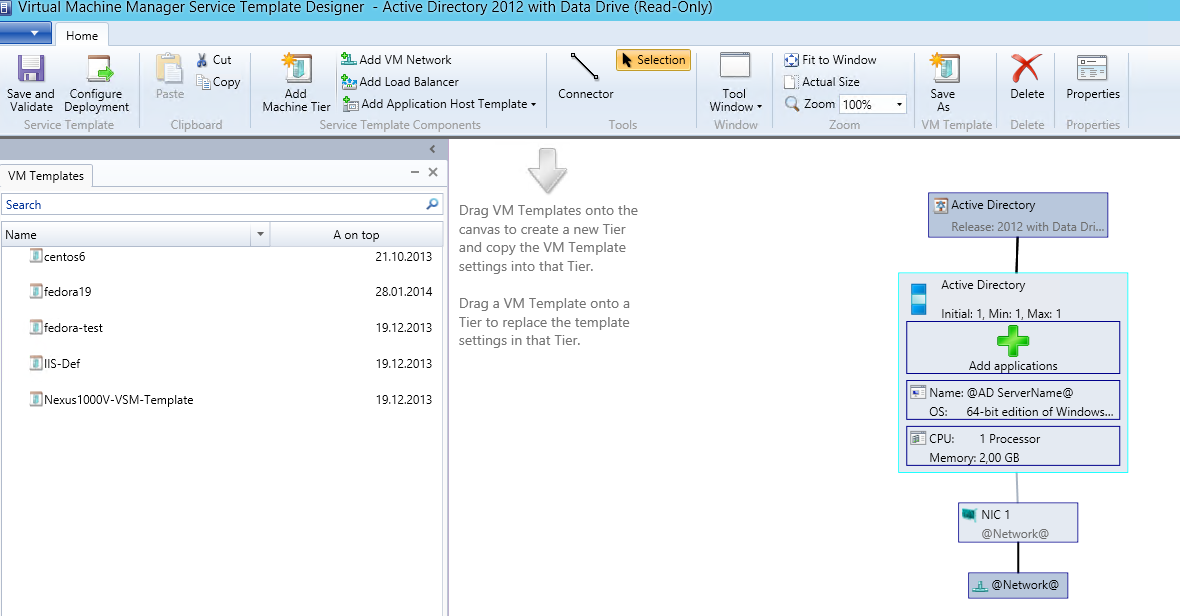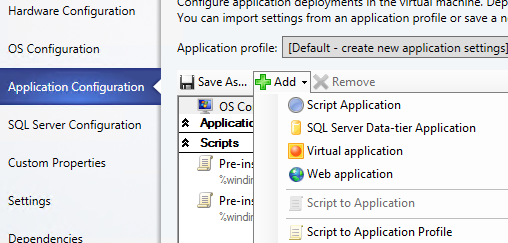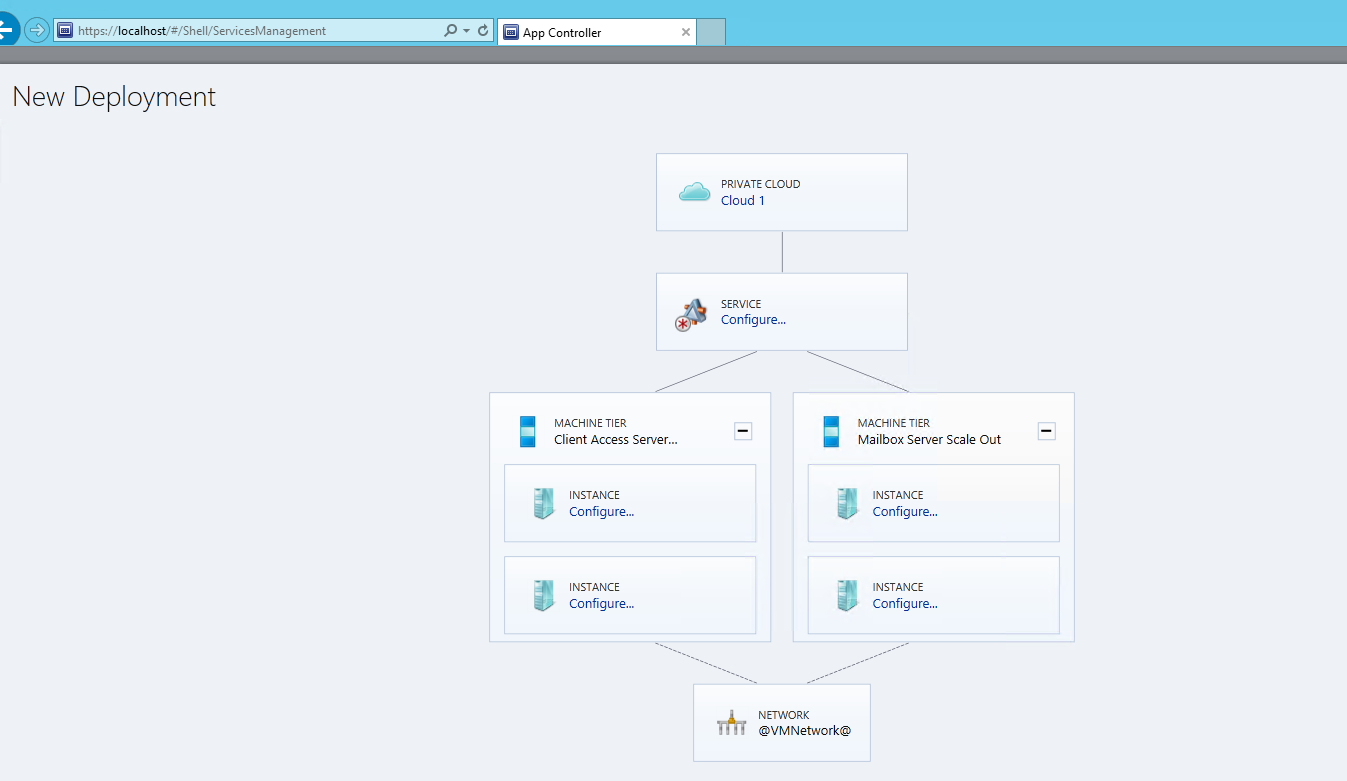Templates for creating services and services for Virtual Machine Manager 2012 R2
Hello everyone, dear colleagues, ladies and gentlemen, enthusiasts!
We have New Year on our nose, and we all continue to delight you with new and interesting stories about the private cloud and server systems - System Center 2012 R2 and Windows Server 2012 R2 .

Today I would like to tell you about another interesting feature of Virtual Machine Manager 2012 R2 - creating and working with service templates. Let's take a closer look at the moments related to this topic.
')
First of all, let’s see with you what a service is in the context of the cloud and System Center in particular.
A service is essentially one or more VMs that are necessary for the execution of an application, which is provided as a service (service). However, services are not only applications: for example, a service may be of an infrastructural nature, i.e. it may be the same VM, but which emulates a hardware device — for example, the Cisco Nexus 1000V Virtual Switch. The service is also represented as a VM, but it performs the function of an infrastructure level in the field of communication and data exchange.
However, a more classic example of a service would be the most common web store - as a rule, it is a three-tier service that consists of the following levels or galleries (tier) - a web server (user interface), a DBMS (data storage location) and a business level -logics (BI, the application itself, its logic and function).
It is important to note that the cloud must have elasticity - and from the point of view of the structure of services, each individual level, the shooting gallery must be able to scale, i.e. change the number of working VMs at a certain level and increase / decrease them, provided that they are located behind a load balancer or in a cluster - thereby ensuring continuity when scaling a service.

Figure 1. An example of a two-level Microsoft Exchange 2013 CU2 service with Mailbox and Client Access roles.
It is also worth noting that service templates, in turn, are composed of a combination of virtual machine templates (essentially a virtual profile with resources), an OS template (setting up guest OS deployment options, domain inclusion, installation of roles and features, etc.) and an application template (web application, script application, SQL application and virtualized App-V application).
Naturally, the process of a consistent and repeatable deployment of a service can be achieved through automation through the use of templates. And here comes the question: “OK, templates are cool! But where to take them, what is their format and if something is ready to be seen? ” Well, let's do everything in order.
The template itself is essentially an XML file in OVF format ( O pen V irtualization F ormat) —that is, an open, vendor-neutral format for describing the structure of service templates — the number of VMs, their characteristics, and other necessary objects) imported into the cloud management system - in our case in System Center 2012 R2 VMM. In fact, having understood the description format, you can independently create ready-made templates from multi-level components for further use. Well, for example, you can deploy Active Directory or Exchange 2013 and Lync 2013 at the level of templates — well, don't forget about SQL Server, SharePoint and third-party solutions — Oracle DB can also be deployed from a template.

Figure 2. Sample XML description of a template in OVF format.
Well, I see how everyone's eyes lit up with phrases about automatic deployment of AD or Exchange and others - after all, this can really come in handy for many, especially in a multi-tenant (multi-tenant) environment. And here comes the STEK (Service Template Example Kit) - a ready-made set of templates for the most common applications and services (to be exact, those I mentioned above. Actually clicking a little higher you will get to the page with an accessible list of templates). I recommend that you familiarize yourself with these templates and try to deploy the corresponding services. After mastering, it is quite possible to describe the service yourself, which will include the sequential deployment of a domain controller and the subsequent deployment of services and Exchange or Lync - I personally found this process to be very exciting and interesting - I learned how to deploy MS services automatically, and also to operate with the description of templates in OVF - not bad, I can tell you, I have pumped!
And finally it remains to tell you that each template has its own version, and with the support of versioning, i.e. Changes to the composition and structure of the service can be updated and publish corrected / updated / modified versions of your application without stopping the user with the current version of the service. It is necessary to specify the version of the application, in an increasing digital format, on the basis of this information, versioning is tracked - it is indicated when creating / updating a template.

Figure 3. The template version is responsible for the service update process.
Well, in fact, the version of the service depends on the changes that occur with the application itself. Those. it is enough to specify the new version of the application, its assembly or package, specify the new version of the release and publish the service. If the service has already been deployed by the user, then after some time (relatively small) he will receive a notification about the availability of a new version of the service - and he will be able to upgrade to it.

Figure 4. Application types for deployment based on a service template.
Well, before you generally publish a service, I strongly recommend that you test its performance and try deploying it by clicking on the Configure Deployment button - thus you will definitely see that the application or service is deployed and works as it should, as well as that he has all the necessary conditions and resources to work.
After that, you can publish it and give end users the opportunity to receive your applications and services automatically through the self-service portal. This can be done by using the App Controller 2012 R2 self-service portal, which is also included in the System Center package.

Figure 5. Deploying the service using the App Controller self-service portal.
Download the current versions of our products here:
Windows Server 2012 R2 - technet.microsoft.com/en-US/evalcenter/dn205286
System Center 2012 R2 - technet.microsoft.com/en-RU/evalcenter/dn205295
Thank you all for your attention,
Hope that was helpful!
See you soon,
Fireman,
George A. Gadzhiev.
We have New Year on our nose, and we all continue to delight you with new and interesting stories about the private cloud and server systems - System Center 2012 R2 and Windows Server 2012 R2 .

Today I would like to tell you about another interesting feature of Virtual Machine Manager 2012 R2 - creating and working with service templates. Let's take a closer look at the moments related to this topic.
')
Service and cloud
First of all, let’s see with you what a service is in the context of the cloud and System Center in particular.
A service is essentially one or more VMs that are necessary for the execution of an application, which is provided as a service (service). However, services are not only applications: for example, a service may be of an infrastructural nature, i.e. it may be the same VM, but which emulates a hardware device — for example, the Cisco Nexus 1000V Virtual Switch. The service is also represented as a VM, but it performs the function of an infrastructure level in the field of communication and data exchange.
However, a more classic example of a service would be the most common web store - as a rule, it is a three-tier service that consists of the following levels or galleries (tier) - a web server (user interface), a DBMS (data storage location) and a business level -logics (BI, the application itself, its logic and function).
It is important to note that the cloud must have elasticity - and from the point of view of the structure of services, each individual level, the shooting gallery must be able to scale, i.e. change the number of working VMs at a certain level and increase / decrease them, provided that they are located behind a load balancer or in a cluster - thereby ensuring continuity when scaling a service.

Figure 1. An example of a two-level Microsoft Exchange 2013 CU2 service with Mailbox and Client Access roles.
It is also worth noting that service templates, in turn, are composed of a combination of virtual machine templates (essentially a virtual profile with resources), an OS template (setting up guest OS deployment options, domain inclusion, installation of roles and features, etc.) and an application template (web application, script application, SQL application and virtualized App-V application).
Service Templates
Naturally, the process of a consistent and repeatable deployment of a service can be achieved through automation through the use of templates. And here comes the question: “OK, templates are cool! But where to take them, what is their format and if something is ready to be seen? ” Well, let's do everything in order.
The template itself is essentially an XML file in OVF format ( O pen V irtualization F ormat) —that is, an open, vendor-neutral format for describing the structure of service templates — the number of VMs, their characteristics, and other necessary objects) imported into the cloud management system - in our case in System Center 2012 R2 VMM. In fact, having understood the description format, you can independently create ready-made templates from multi-level components for further use. Well, for example, you can deploy Active Directory or Exchange 2013 and Lync 2013 at the level of templates — well, don't forget about SQL Server, SharePoint and third-party solutions — Oracle DB can also be deployed from a template.

Figure 2. Sample XML description of a template in OVF format.
STEK - Service Template Example Kit
Well, I see how everyone's eyes lit up with phrases about automatic deployment of AD or Exchange and others - after all, this can really come in handy for many, especially in a multi-tenant (multi-tenant) environment. And here comes the STEK (Service Template Example Kit) - a ready-made set of templates for the most common applications and services (to be exact, those I mentioned above. Actually clicking a little higher you will get to the page with an accessible list of templates). I recommend that you familiarize yourself with these templates and try to deploy the corresponding services. After mastering, it is quite possible to describe the service yourself, which will include the sequential deployment of a domain controller and the subsequent deployment of services and Exchange or Lync - I personally found this process to be very exciting and interesting - I learned how to deploy MS services automatically, and also to operate with the description of templates in OVF - not bad, I can tell you, I have pumped!
Template as a tool for managing the life cycle of a service and application
And finally it remains to tell you that each template has its own version, and with the support of versioning, i.e. Changes to the composition and structure of the service can be updated and publish corrected / updated / modified versions of your application without stopping the user with the current version of the service. It is necessary to specify the version of the application, in an increasing digital format, on the basis of this information, versioning is tracked - it is indicated when creating / updating a template.

Figure 3. The template version is responsible for the service update process.
Well, in fact, the version of the service depends on the changes that occur with the application itself. Those. it is enough to specify the new version of the application, its assembly or package, specify the new version of the release and publish the service. If the service has already been deployed by the user, then after some time (relatively small) he will receive a notification about the availability of a new version of the service - and he will be able to upgrade to it.

Figure 4. Application types for deployment based on a service template.
Well, before you generally publish a service, I strongly recommend that you test its performance and try deploying it by clicking on the Configure Deployment button - thus you will definitely see that the application or service is deployed and works as it should, as well as that he has all the necessary conditions and resources to work.
After that, you can publish it and give end users the opportunity to receive your applications and services automatically through the self-service portal. This can be done by using the App Controller 2012 R2 self-service portal, which is also included in the System Center package.

Figure 5. Deploying the service using the App Controller self-service portal.
Download the current versions of our products here:
Windows Server 2012 R2 - technet.microsoft.com/en-US/evalcenter/dn205286
System Center 2012 R2 - technet.microsoft.com/en-RU/evalcenter/dn205295
Thank you all for your attention,
Hope that was helpful!
See you soon,
Fireman,
George A. Gadzhiev.
Source: https://habr.com/ru/post/207050/
All Articles